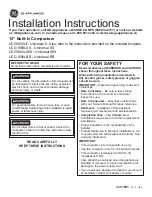
29
s
ectiOn
6 — M
aintenance
& a
djustMents
Place a small pan under the pump motor frame. Remove fill
8.
oil cap from hydraulic reservoir for faster drainage. Remove
nut caps and drain oil from both left and right pumps.
Replace and retighten nuts. See Fig. 6-2.
Remove the three screws from the top of the oil filter and
9.
replace the oil filter element. Coat the sealing surface
with Shell Rimula 15W40 oil or equivalent. Install the three
screws back into the oil filter.
Add proper amount of hydraulic oil to reservoir.
10.
Run and purge pumps and motors. Check oil level.
11.
Add proper amount of hydraulic oil to reservoir and repeat
12.
step 11.
Hydraulic System
Hoses
Check the hoses from the hydraulic oil tank to the oil filter to
the hydraulic lines daily for leaks or abrasion and replace any
damaged hoses. Make certain there are no kinks or twists in any
hose. Look for a flattened condition or any leaks and repair or
replace as necessary. A flattened or leaking suction hose will
permit cavitation to develop which can destroy the pumps in a
short time.
Hydraulic Oil Tank and Filter
NOTE:
Change the hydraulic oil and the oil filter after the first 50
hours of operation.
To drain the hydraulic oil tank:
Place a 2 gallon drain pan under the drain plug on the
1.
bottom of the hydraulic oil tank.
Remove the drain plug, drain the tank, then replace the
2.
plug.
Place the drain pan under the filter and remove the filter by
3.
unscrewing in a counterclockwise direction. The filter will
be full of oil, so empty it into the drain pan. You don’t have
to drain the rest of the hydraulic system.
Fill the replacement filter with a good grade of 15W-40 oil
4.
and lubricate the sealing surface.
Screw the filter onto the filter base until it seats and then
5.
another one-half turn to seal.
NOTE:
Always wipe off the hydraulic tank fill cap and the
area around it before removing the cap to prevent dirt
from contaminating the oil.
Remove the fill cap and fill the tank with the same 15W-40
6.
oil selected for the filter until the oil level is up to the level
of the second hole in the fill tube. Leave this air space for
expansion.
Start the engine and let it run at Lo-idle for about five
7.
minutes. Check the filter for leaks. Idling the engine and
the pumps in this way will purge any air from the system.
Shut off the engine and recheck the oil level in the tank.
8.
Top-off if necessary until the oil level is up to the second
hole in the fill tube.
NOTE:
After unit is up to operating temperature, turn off
engine and re-check hydraulic oil. If oil appears foamy or
contains excessive air bubbles, DO nOT OPERATE UnIT.
Contact service technician.
Contaminants or foreign matter in the oil will also damage the
pumps . To prevent this:
Use a filter that captures particles as small as 30 microns or
•
30 millionths of a meter in diameter.
Be very careful when you remove or repair a component in
•
the hydraulic system. Thoroughly clean off any component
before you work on it.
Plug the ends of any hose or line you remove with a rubber
•
or plastic plug.
Use plastic caps to seal off the ends of hydraulic fittings.
•
Place any component you remove in a clean plastic bag so
•
it can’t pick up dust or dirt.
Clean your hands frequently when working on the
•
hydraulic components.
NOTE:
The pumps are not owner-repairable. If a pump fails,
contact your Service Center. Do not disassemble the pump.
General Battery Information
WARNING!
Should battery acid accidentally splatter into
•
the eyes or onto the skin, rinse the affected area
immediately with clean cold water. If there is any
further discomfort, seek prompt medical attention.
If acid spills on clothing, first dilute it with
•
clean water, then neutralize with a solution of
ammonia/water or baking soda/water.
NEVER connect (or disconnect) battery
•
charger clips to the battery while the charger is
turned on, as it can cause sparks.
Keep all sources of ignition (cigarettes,
•
matches, lighters) away from the battery. The gas
generated during charging can be combustible.
Screw
Hydraulic Filter
Figure 6-2















































